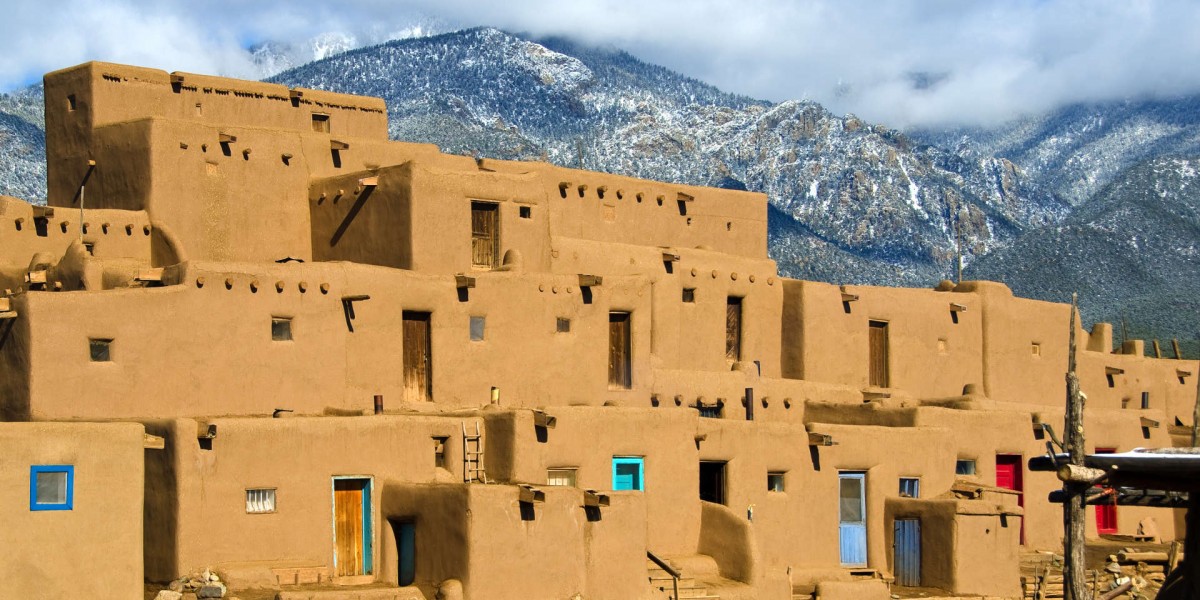
Dancing with deer
My arrival to Taos Pueblo, New Mexico was distinctly underwhelming, greeted as I was in January by a scruffy car park of mud and melting snow. My fears of a hammy tourist show were not quelled by the sultry lady at the kiosk where I paid my admission fee. I’d love to have taken some photos of my time there but the tribal police told me in no uncertain terms that all cameras were strictly banned, especially on the day of a ceremonial dance.
But walking into Taos Pueblo itself was a different sensation entirely. The entrance opens up to a large grassy area and on either side sit the red adobe buildings, arranged in tiers as much as three high. Through the middle runs a small stream, partly iced over now and crossed by two small wooden bridges. Snow was still on the ground, the sky was a clear blue in the crisp mountain air and tendrils of smoke drifted from the chimneys. Groups of seemingly feral dogs were chasing each other in circles, running between the smouldering remains of bonfires that were left from Christmas celebrations. Looking around there was nothing that resembled modernity; no tarmac, no bricks, no electricity wires, no shop signs, nothing. Even in the remotest African village there’s sure to be a Coke or mobile phone logo somewhere but not here. Other than a smattering of Gortex clad tourists, still visibly recoiling from their inability to post to Instagram, we could have returned to the middle ages. Taos Pueblo, ancestral home of a Tewa-speaking Native American tribe, is the oldest continually inhabited settlement in the United States. It was built somewhere between 1000 and 1450 with one of the few concessions over the years being the introduction by the Spanish of the pretty turquoise doors that now adorn each home.
RELATED: Taking the high road to Taos from Santa Fe
By chance I had arrived on Three Kings Day, a feast day in the pueblo which was to be celebrated with the deer dance. Now well past the stated midday start time, groups of people, a mixture of tourists and locals, were waiting on either side of the creek. There was an air of anticipation and every so often women would pop their heads out of the blue doorways or walk across the roofs that linked the second floor homes. Definitely in their finery, bright colored shawls covered their shoulders and moccasin boots their feet. For another hour the tension built as the onlookers waited for something to happen. It started with a steady, almost imperceptible drum beat that came from somewhere behind the buildings on the south side of the creek, growing in volume with each strike. Soon a close knit group appeared in the distance, shuffling to the beat of the drum. Moving herdlike, each man had the head of a bison or elk on his shoulders. With the timeless backdrop and smoke in the air, it was a sight that raised the hairs on the back of my neck. The drumming continued to grow louder and a monotonous, melodic chant struck up. Soon another drum beat erupted from the other side of the pueblo followed by a similar antler clad group. The two gatherings slowly made their way to the middle and met at the creek. At a closer distance I could see that all the participants were men but with a full range of ages down to a four or five year old boy, dwarfed by the huge bison head he carried on his shoulders. At the rear of the possession was a row of what I took to be the elders. They weren’t wearing antlers or skins but rather a red earthen paint on their bodies and a feather in their hair. Each carried a drum and sang in a low rolling chant, a look of absolute seriousness on their face. As they passed beneath the tiered adobe buildings the watching women would call out in a high pitched shrill note. Together it made a striking soundtrack.
It was clear that events were in no way directed at the watching tourists and were not for show. Visitors tended to hang back respectfully, not wanting to get in the way of the locals who were in the crowd. Many did not appear to live in the pueblo itself but were clearly part of the community. The singing and dancing continued well into the afternoon in the middle of a large crowd in front of the San Geronimo Church. The significance and meaning of what goes on at the deer dance remains a mystery to me and I know that Taos Pueblo wants to keep it that way.
